You published a few blog posts on your product’s latest features, scheduled some social media posts, and hired an agency to create animated content for YouTube.
A few months in, and crickets.
Sound familiar to you?
Content marketing programs can fail, and that’s because there’s no clear strategy powering them.
Yes, it’s important to publish blog posts, guides, and whitepapers. But publishing for the sake of publishing won’t yield any results.
In this post, we’ll walk you through the importance of building and documenting a content marketing strategy, why you should build one before embarking on a content program, and a ready-to-use framework for you to get started immediately.
We've also included a free downloadable content marketing strategy template built with the framework we identify in this article. It's yours to download, edit, and apply to your business.

👉 Download the Content Marketing Strategy Template
Why is content marketing strategy important?
Content marketing is a strategic marketing approach focused on creating and distributing valuable, relevant, and consistent content to attract and retain a clearly-defined audience — and, ultimately, to drive profitable customer action, says the Content Marketing Institute (CMI).
Having said that, it’s important to know that a content marketing program can support several objectives. Without a clear strategy covering who you’re trying to reach, what you want them to do, and how it helps the brand, it’s likely that your program will be pulled in several directions.
Content marketing has exploded in popularity in recent years, with research from CMI showing that it generates over three times as many leads as outbound marketing. What’s more, it costs 62% less too. Businesses who blog get 126% more leads than those who don’t and the conversion rate for content marketing is six times higher than other methods.
Despite the benefits of content marketing for businesses, there are many marketers who don’t know how to use it properly. 63% of businesses don’t have a documented content marketing strategy, according to the CMI.
That’s a shame because content marketers with a documented strategy are 4x+ more likely to report their efforts as successful.
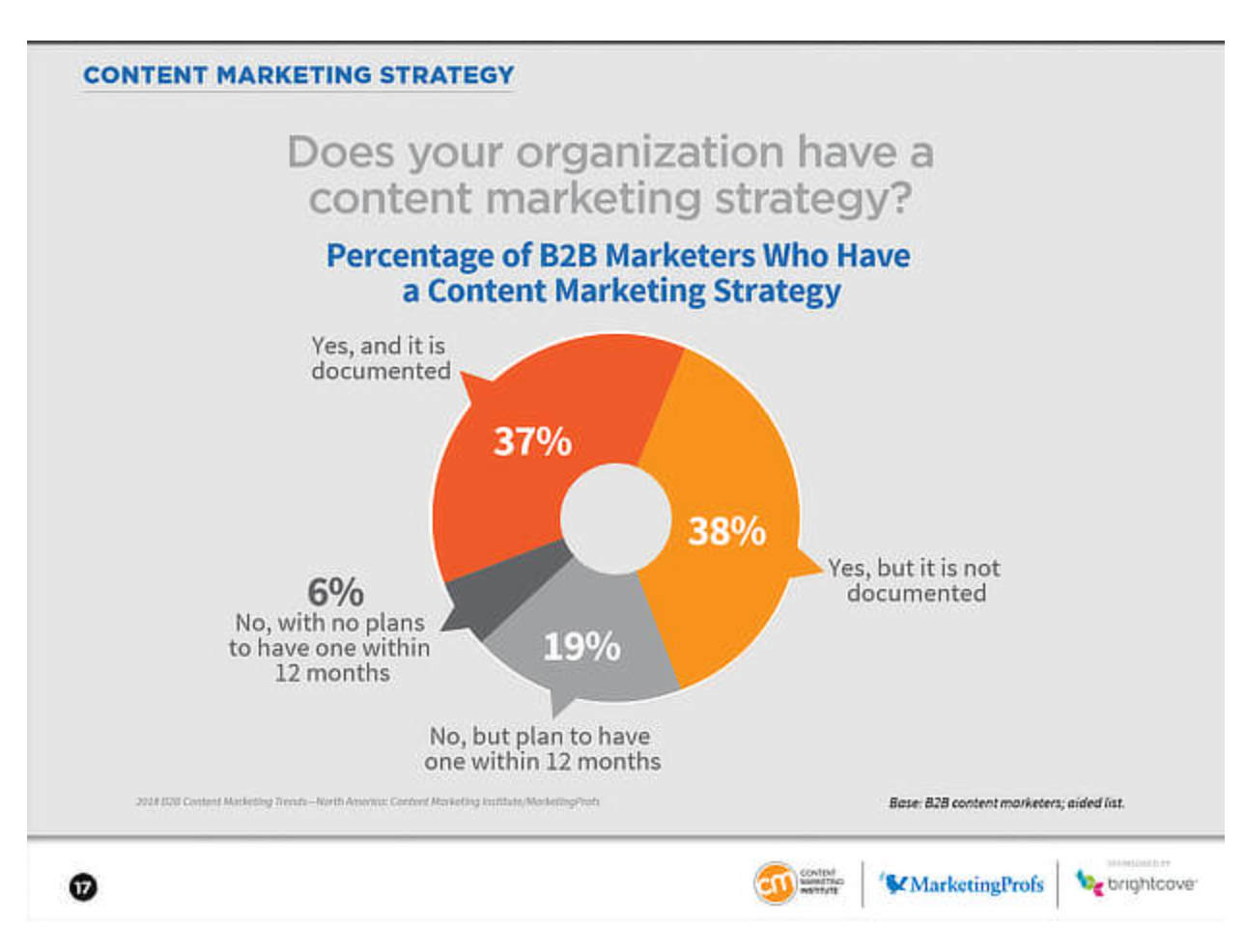
Let’s read on to understand a framework for building a content marketing strategy of your own.
How do I build a content marketing strategy?
Developing a content marketing strategy takes time. Good strategy requires extensive research to truly understand your audience. Accurately figuring out who they are, what content will inform and delight them, and where they consume content isn’t done in a day or two.
On the other hand, it’s necessary to not get weighed down with paralysis by analysis. Spending weeks doing research can delay all of the activities that actually produce results
At the end of the day, all content marketing strategy is ultimately based upon the answer to these 3 questions:
- What are our goals?
- Who is our audience?
- What resources do we have?
Lower down this post, we’ve also included a real-world example of a content marketing strategy we did for a healthy snacks subscription business. The strategy is yours to download and edit according to your needs.
Now let’s dive in.
What are our goals?
Answering this question helps you understand why you’re doing content marketing in the first place. Each organization has its unique needs and problems. Broadly speaking, however, the reason that you decided to embark on the content marketing journey can be broken down into two buckets.
You either wish to increase revenue or decrease costs.
The increased revenue bucket can entail one or more of the following goals:
- Increase brand awareness
- Widen the pool of prospective customers
- Improve customer engagement and retention
- Boost customer referrals and reviews
- Enhance conversion rates
The decreased cost bucket may require one or more of the following targets:
- Reduce customer churn
- Boost efficiency of the sales team
- Decrease cost per lead
- Lower customer support requests
While your organization may require support in all of the above areas, a content marketing strategy cannot focus on all of these at once. Pick the top 1-3 as your highest priority and aim to address those first. Once that’s done, write it down or put it in a shared document. These will serve as your framework for the tactics you deploy later.
Who is our audience?
A laser-focused recognition of your audience helps you determine the kind of content you should create, the brand voice and tone, and the distribution channels that will be most effective. Are you marketing to healthcare professionals or software engineers? Aim to get to an understanding of these two questions, to begin with:
- Who are our top 2-4 buyer personas that will purchase from us?
- What other audiences will benefit from our content and can help us share it?
Some steps you can take to arrive at this understanding are:
- Process your email list through a tool like Clearbit to pull the name, location, and social media data of your customers.
- Take a look at your Facebook, Twitter, and LinkedIn analytics pages. What basic information can you pull, like gender, age, location, and similar interests?
- If you have Universal Google Analytics set up properly, view the demographic and affinity data provided, and then segment down to customers who have converted in some way.
- Run queries on Facebook Graph Search such as “Pages liked by people who like [My Brand Name]” or “Pages liked by people who like [Competitor Brand Name]”. You’ll see some interesting results in other pages that these audience members follow.
What resources do we have?
A content marketing strategy requires time and expertise in creating, publishing, and distributing content effectively. A full-scale content marketing program means you need expertise in several different areas including writing, editing, design, and possibly other focus areas like video production, podcasts, social media management, email marketing, and more.
And while you may not need all of these skillsets upfront to execute your content marketing strategy, it’s definitely worth taking a step back to assess what you’re good at and areas where you fall short.
A great way to do this process is to create a spreadsheet with all teams or team members who might contribute to the content marketing process, and then categorize their contributions (eg “subject matter expertise” or “design resources”), and finally, estimate their time for contributions (eg “one day a month” vs “full-time”).
At this stage, you should also aim to assess what budget you can allocate for outside team support. This will help you determine if you need to pull in freelance or agency support, and to what extent you can engage them.
How do I execute my content marketing strategy?
Once you have a high-level understanding of your content marketing goals, the audiences you serve, and the resources that you can call upon, the next step is to build out a tactical plan.
This is where we start to get specific about our goals: the aim is to define them in the clearest of terms so that you have a benchmark for what you want to achieve and the eventual outcome.
Let’s say you decided on “increasing brand awareness” as a goal for your content marketing strategy in the previous step. At the execution stage, you will need to establish quantifiable metrics that demonstrate you’re on your way to achieving this.
Specific goals for increasing brand awareness could be one or more of the following:
- Growing social media followers
- Brand name mentions on sites and communities where your customers hang out, such as Reddit or Quora
- Increase in branded search volume
- Boost in overall site traffic, complemented with greater inbound PR / media requests
Once we’ve identified these goals, it’s recommended to get even more granular and time-bound. Yes, we’d like to increase our Twitter followers and organic brand name mentions. But by how much and within what timeframe? A clear metric for success will help your team identify exactly what they need to achieve. It can also factor into quarterly OKR / KPI planning.
An example of how this might look like is “Within six months, we want our content marketing efforts to help grow our Twitter followers to 10,000 and an increase in brand mentions of 300% year-on-year.”
Once this goal is established and agreed upon, it becomes much easier to figure out the tactical steps ahead. These include publishing responsibilities & cadence, distribution channels, reporting dashboards, and more.
To recap, your tactical goals should be SMART:
- Specific
- Measurable
- Attainable
- Realistic
- Time-bound
What are we going to publish and how often?
Now that we’ve decided on our tactical goals, the next step is to figure out what content will help achieve those targets. Brand awareness goals aren’t conversion-driven; the aim is to put your brand in front of people who might not have heard of you before. Content that tries to ask for a sale immediately won’t achieve this goal; you must take a more nuanced approach.
Your target is to feed them valuable and relevant content with the hope that they find it useful, and that they eventually become loyal customers of your business.
Popular automation platform Zapier, for example, knocks it out of the park. Zapier’s target audience is marketing, SEO, and growth folks who use multiple apps for their tech stack. Its blog has lots of non-salesy, actionable advice that marketing professionals can benefit from:
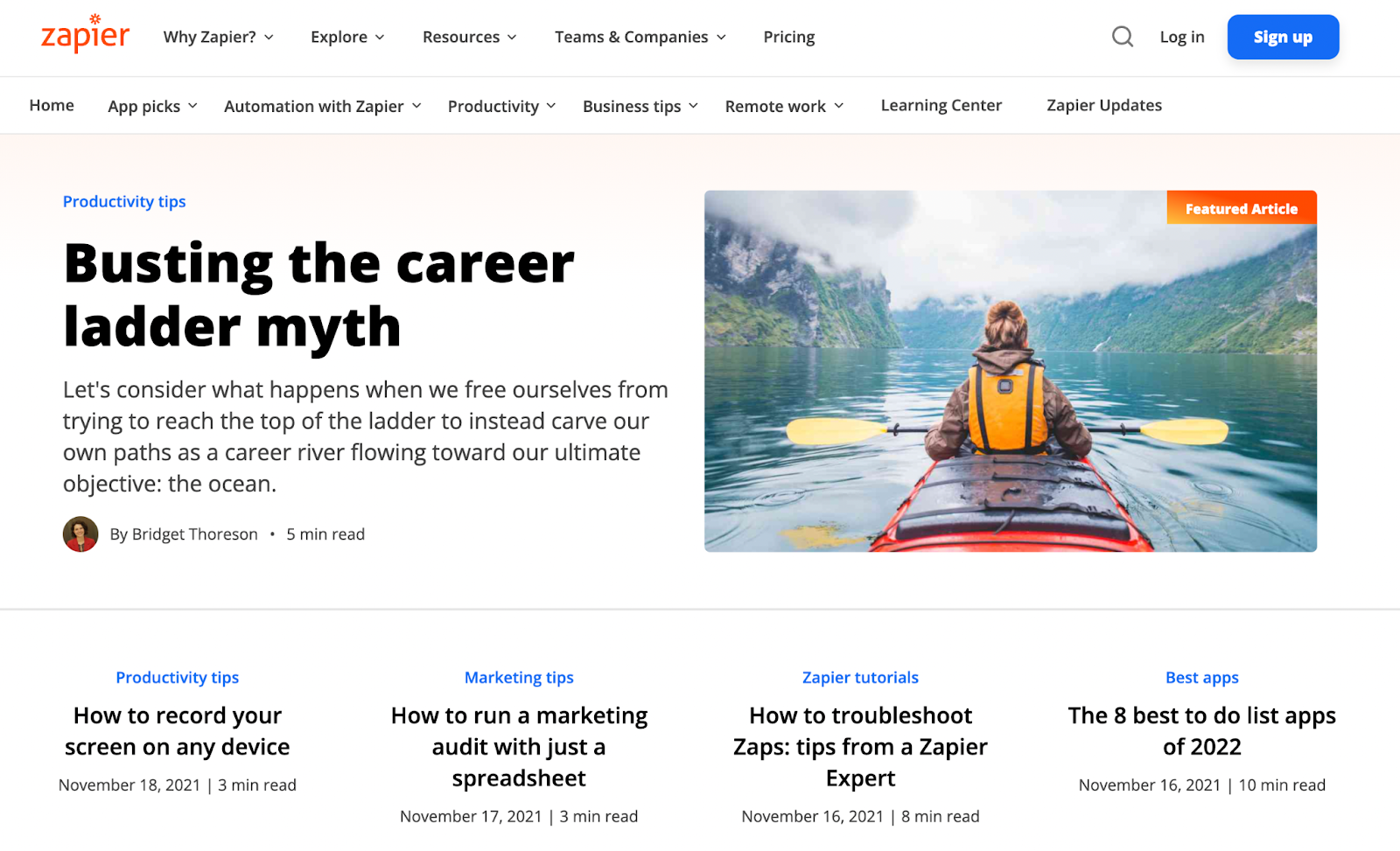
What Zapier does very cleverly, though, is that it first recommends apps and platforms that directly integrate with the platform. The “best to do list apps” post, for example, is a detailed guide of popular apps in the category, followed by a handy reminder that they integrate with Zapier.
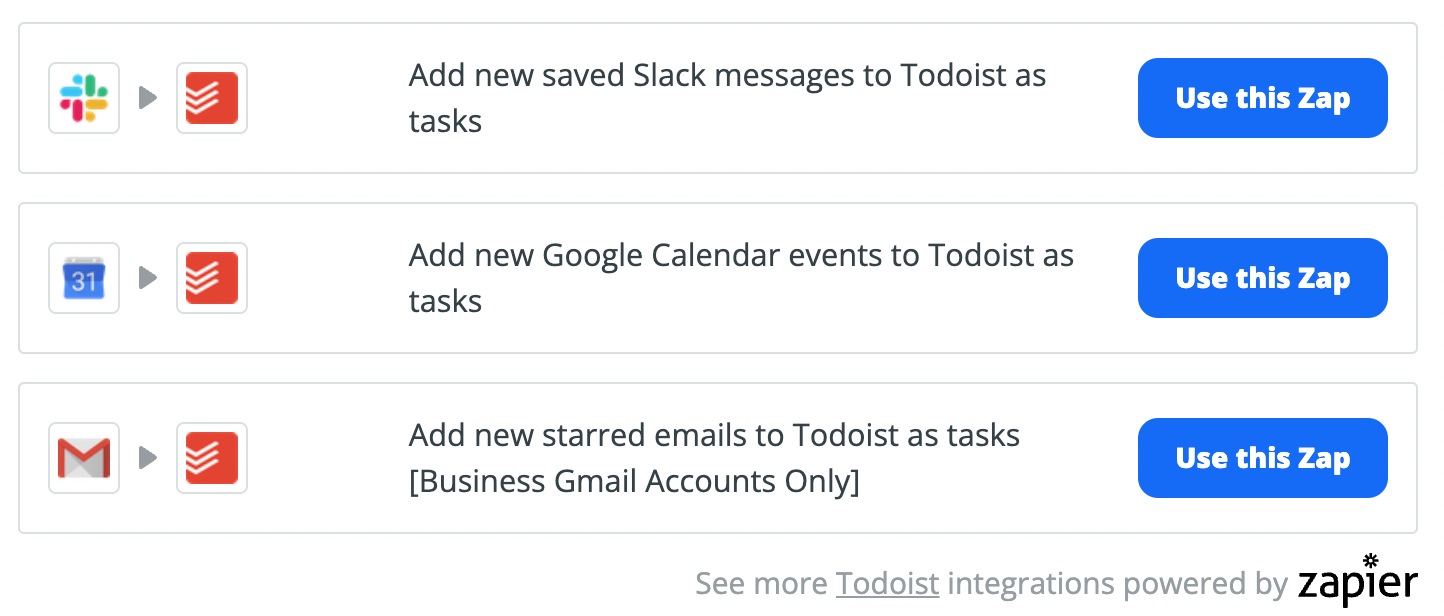
The challenge for marketing professionals is keeping tabs on all these different platforms. For example, you may be prompted on a new to-do item via a Slack message. Without Zapier, you have to manually open your task manager app and add a new item. That adds an additional step to your workflow which could be missed. Zapier conveniently reminds its audience that this task can be automated.
Someone searching for the “best to do list apps” may not have even heard of Zapier before. By catering to this search intent, the automation company gives its readers both great content and the opportunity to grow its brand visibility.
Zapier’s strategy is working. The blog gets over 1 million monthly visits through organic search, ranks for over 800,000 keywords, and has an estimated traffic value of over $2.3 million. This means Zapier would have to run $2.3 million worth of paid campaigns to drive the same traffic numbers.

Of course, the question of what to publish will depend on your industry and niche. If you’re building productivity and project management software, then the value you add to your users is efficient staff members, engaged teams, and higher employee satisfaction. Understanding your audience’s pains and struggles will help you produce content that speaks to their needs, and ultimately determine your content marketing efforts.
A publishing cadence, or the frequency of your efforts, ties back into available resources and budget. That’s where an editorial calendar adds value: you’re able to assign tasks and responsibilities to team members and outsource as needed
How will we distribute content?
A content marketing strategy is incomplete without a distribution plan. And even if your approach is to write SEO-optimized content, you can’t solely rely on search engines to do the task for you.
A distribution strategy aims to feed content in channels where your audience hangs out the most, such as email, social media, or third-party sites like Reddit. You might also wish to take advantage of paid search campaigns in an effort to build up an audience quickly.
Research shows that there are over 7 million blog posts published every single day. So if you’re not investing time in distributing and promoting your content, you’re not going to get maximum value for your efforts.
One thing I've noticed is that a lot of marketing teams get into a habit of creating for the sake of creating. More blog posts. More ebooks. More guides. More videos.
— Ross Simmonds (@TheCoolestCool) November 8, 2021
But don't actually distribute those things.
This is a mistake.
Create once. Distribute forever.
A well-oiled content distribution plan is even more important when your goal is to increase brand awareness. You may be publishing great content, but your brand isn’t strong enough yet to have a large audience that will do most of the heavy lifting.
How will we track progress on our goals?
You may have set yourself time-bound targets for your content marketing strategy, but it’s still imperative that you establish a reporting cadence to understand whether you’re on track to achieving them. If you gave yourself six months to achieve a specific target, don’t check the results at the end to figure out how successful you were.
Your weekly or bi-weekly marketing meeting is a good place to start. Here, you’re able to check week-over-week performance on things like social media growth, inbound traffic, and brand mentions. If something isn’t working, you can identify the issues early and arrive at a solution. And if you see a specific tactic that’s doing better than expected, perhaps it’s time to double down in an attempt to surpass your goals.
Some high-level metrics that correspond to the customer’s purchase journey are:
Top-of-Funnel:
- Goal: Build brand visibility with our target audiences.
- Metrics: Links, social shares, traffic, page views.
Middle-of-Funnel:
- Goal: Build engagement with our site visitors and educate them on product and service options.
- Metrics: Email subscriptions, repeat visitors, content downloads.
Bottom-of-Funnel:
- Goal: Convert engaged visitors who are viewing product and service-related website content.
- Metrics: Goal conversions from leads, online sales and revenue for e-commerce.
Retention (Post-Funnel):
- Goal: Build up customer retention, repeat business, referrals, and public reviews.
- Metrics: Engagement with support content, customer churn for retention businesses, repeat purchases, etc.
Content marketing strategy template
We’ve given you a lot of information above, so it’s okay if you’re feeling overwhelmed. To help you out, we’ve included a content marketing strategy template based on our framework.
This is a real-world example of a content marketing strategy we did for a healthy snacks subscription startup, diving into specific goals, KPIs for success, target personas and their demographic data, and the tactical methods to smash our targets.

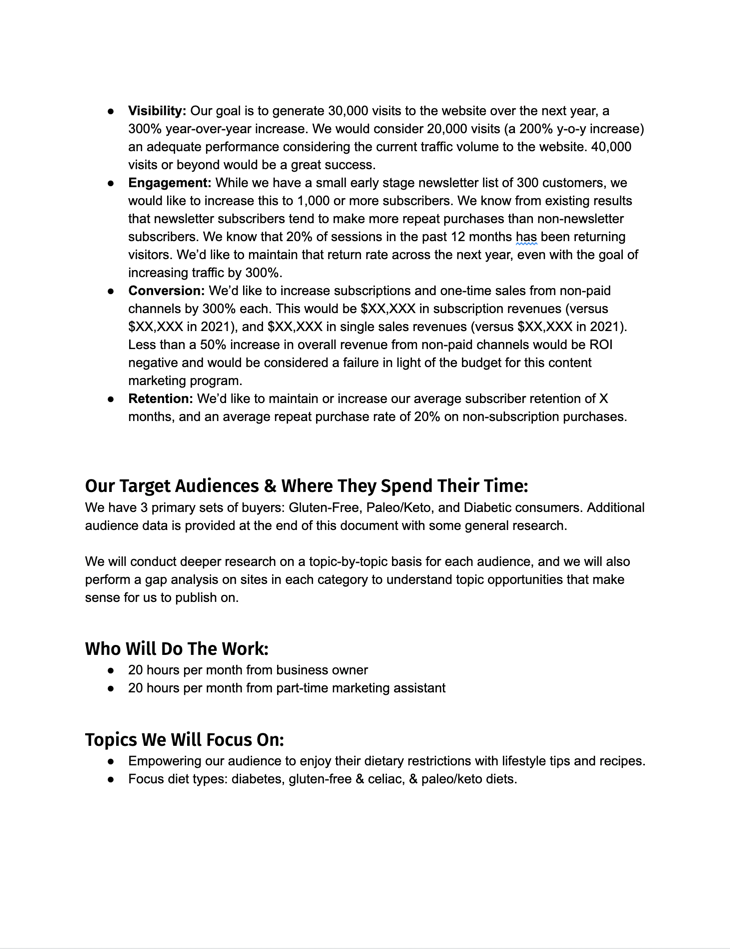
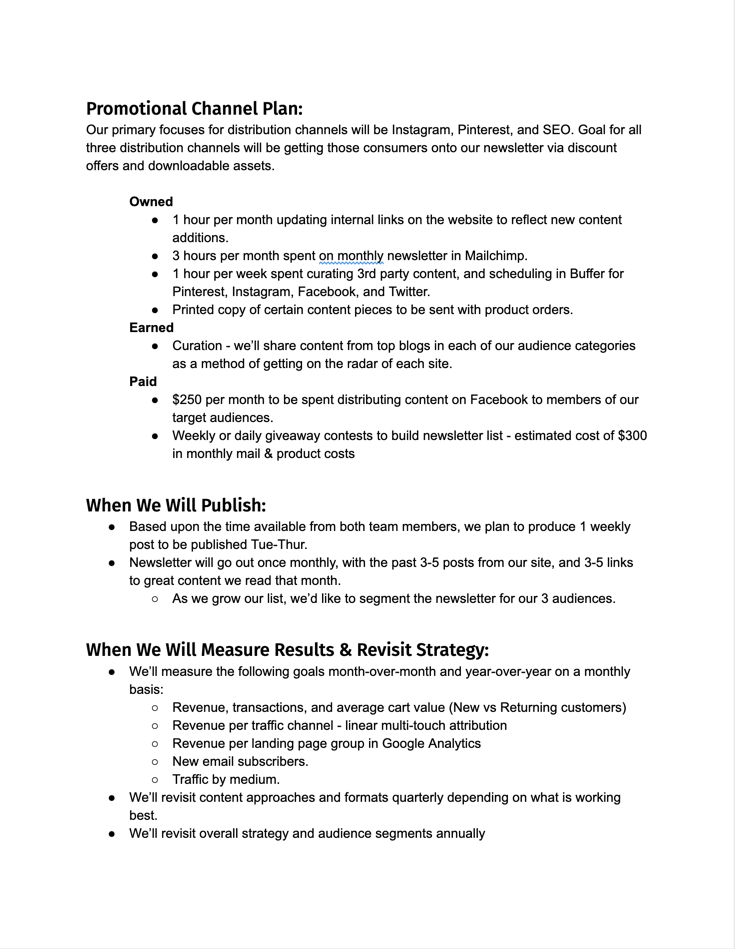
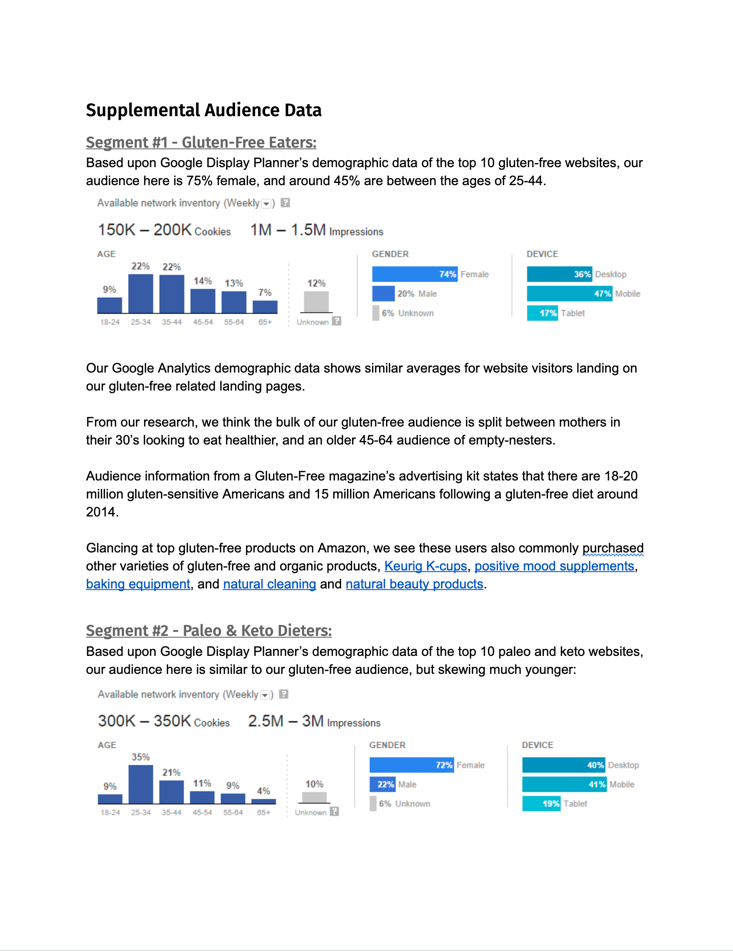
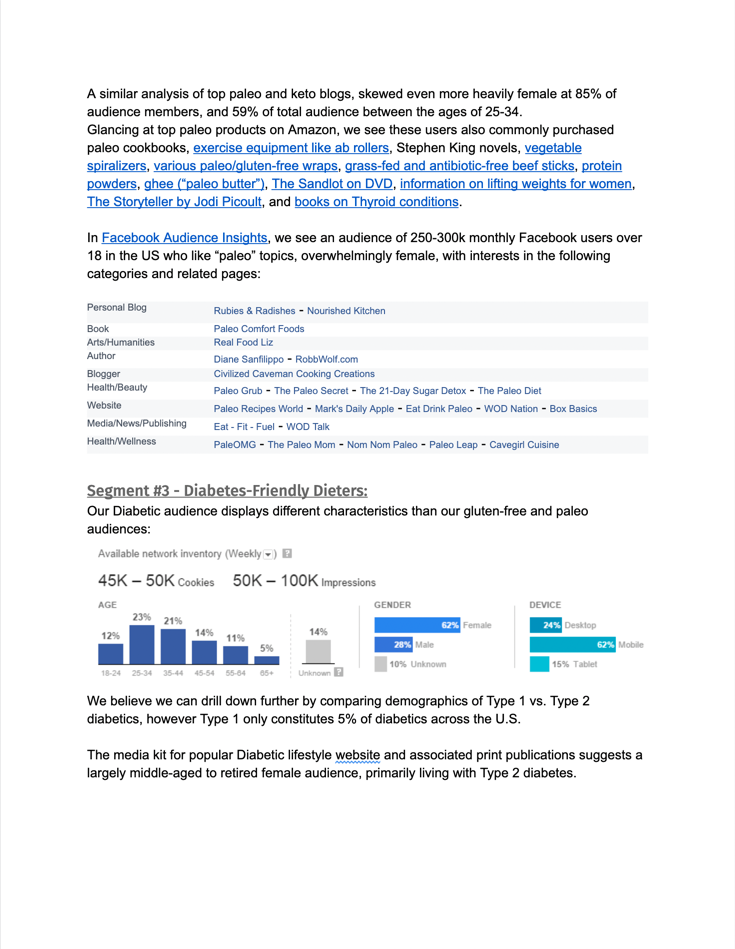
👉 Download the Content Marketing Strategy Template
Content marketing strategy examples
Other than the examples listed in this post, there are many other great brands doing wonders with their content marketing. Our friends at the Content Marketing Institute, Moz, and Hubspot are a few that have shared their templates of how to build a content marketing strategy. You might benefit from reading them:
- How to Develop a Content Strategy in 7 Steps: A Start-to-Finish Guide by Hubspot
- The Content Strategy Template by Moz
- The Essentials of a Documented Content Marketing Strategy by Content Marketing Institute
Want to see how Content Harmony helps you build content that outranks the competition?
The blog post you just read scores Good in our Content Grader for the topic "what is content marketing strategy".
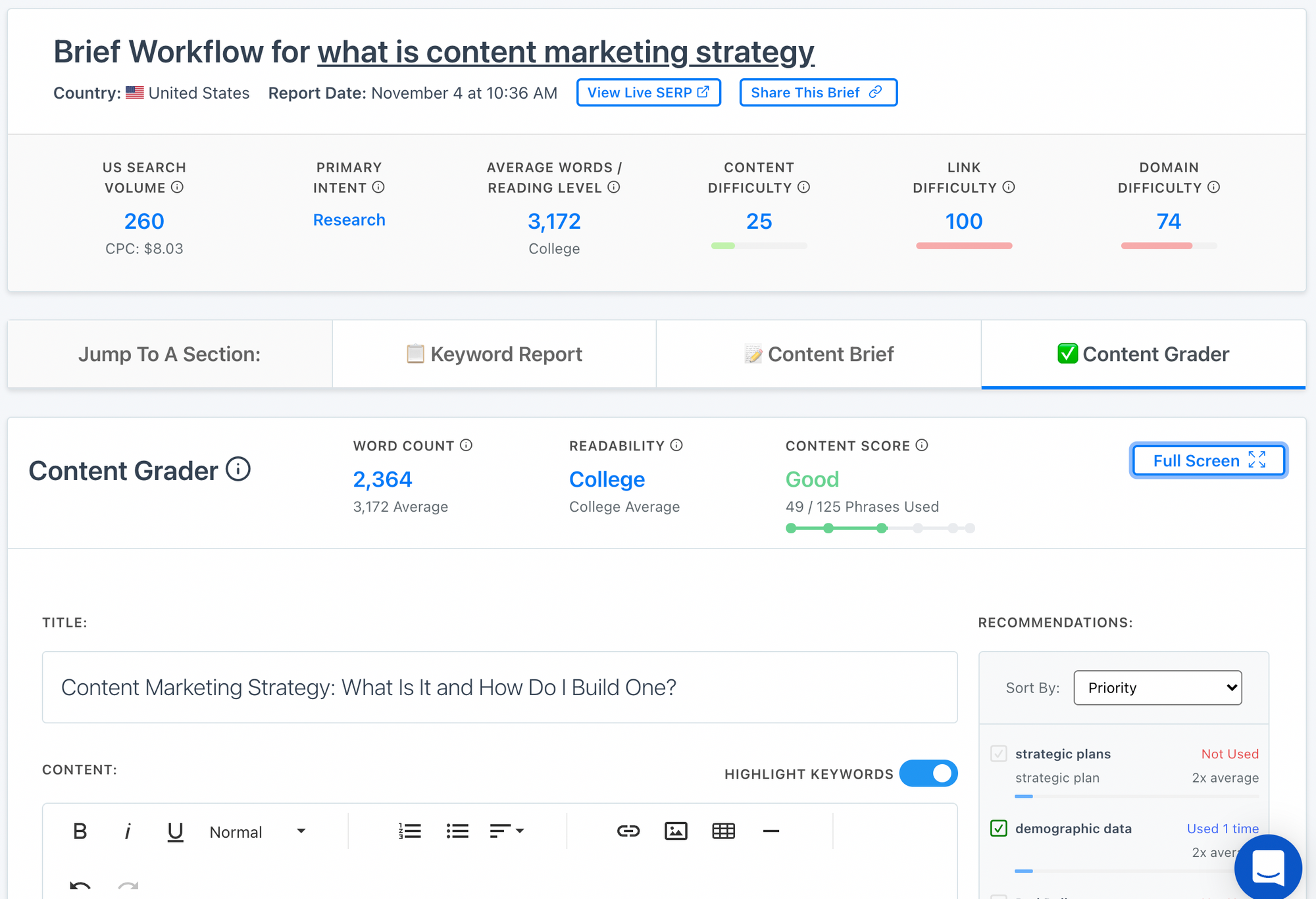
Grade your content against an AI-driven topic model using Content Harmony - get your first 10 credits for free when you schedule a demo, or sign up here to take it for a spin on your own.
👉 Get Your First 10 Briefs For $10
✉️ Get an email when we publish new content:
Don't worry, we won't bug you with junk. Just great content marketing resources.
Ready To Try
Content Harmony?
Get your first 10 briefs for just $10
No trial limits or auto renewals. Just upgrade when you're ready.

You Might Also Like:
- Content Brief Templates: 20 Free Downloads & Examples
- The Keyword Difficulty Myth
- How To Find Bottom of Funnel (BoFU) Keywords That Convert
- Bottom of Funnel Content: What Is BOFU Content & 10 Great Examples
- 20 Content Refresh Case Studies & Examples: How Updating Content Can Lead to a Tidal Wave of Traffic 🌊
- How to Create Editorial Guidelines [With 9+ Examples]
- Content Marketing Roles
- How To Write SEO-Focused Content Briefs
- The Content Optimization Framework: [Intent > Topic > UX]
- How To Update & Refresh Old Website Content (And Why)
- 12 Content Marketing KPIs Worth Tracking (And 3 That Aren't)
- 16 Best Content Writing Tools in 2024 (Free & Paid)
- How To Create Content Marketing Proposals That Land The Best Clients
- What Is A Content Brief (And Why Is It Important)?
- How To Create A Dynamite Editorial Calendar [+ Free Spreadsheet Template]
- How to Use Content Marketing to Improve Customer Retention
- Types of Content Hubs: 5 Approaches & 30+ Examples
- How To Do A Content Marketing Quick Wins Analysis
- There's A Better Way To Measure Keyword Difficulty
- There's A Better Way To Classify Search Intent

